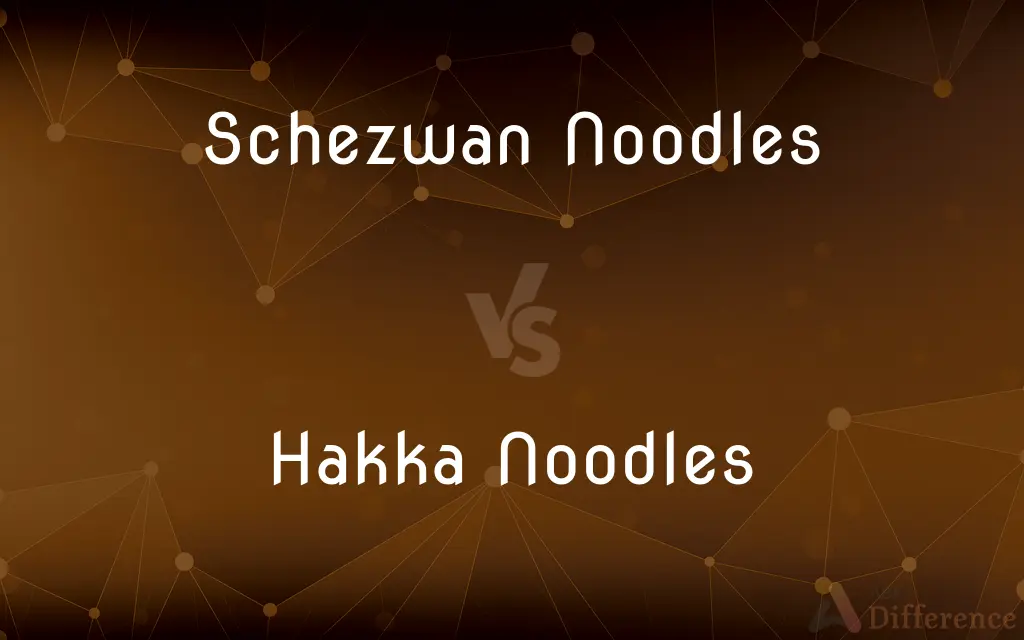Schezwan Noodles vs. Hakka Noodles — What's the Difference?
Edited by Tayyaba Rehman — By Fiza Rafique — Published on December 27, 2023
Schezwan Noodles are spicy, made with Szechuan sauce, while Hakka Noodles are stir-fried with veggies and have a milder flavor.

Difference Between Schezwan Noodles and Hakka Noodles
Table of Contents
ADVERTISEMENT
Key Differences
Schezwan Noodles hail from the Szechuan region of China, embodying the fiery essence of its native cuisine. In contrast, Hakka Noodles belong to the culinary traditions of the Hakka people, presenting a more subtle play of flavors.
Both Schezwan Noodles and Hakka Noodles use long noodles as a base, but the former integrates a fiery, spicy Szechuan sauce that packs a punch. Hakka Noodles, on the other hand, emphasize stir-frying the noodles with a variety of vegetables, often presenting a lighter, more refreshing taste.
For lovers of spicy and bold flavors, Schezwan Noodles become the immediate choice. The blend of garlic, red chilies, and peppercorns in its sauce is unmistakable. Conversely, Hakka Noodles serve as a milder alternative, allowing the simple tastes of vegetables and noodles to shine through.
While Schezwan Noodles are recognized by their deep red hue and rich sauce, Hakka Noodles often feature a slightly browned appearance due to the stir-frying process. Despite their differences, both variants represent the diversity and depth of Asian cuisine.
Comparison Chart
Origin
Szechuan region of China
Hakka people of China
ADVERTISEMENT
Flavor Profile
Spicy, bold
Mild, balanced
Sauce Used
Szechuan sauce
Soy sauce-based
Main Ingredients
Noodles, Szechuan sauce, meat/veggies
Noodles, veggies, light seasoning
Color & Appearance
Reddish due to sauce
Light brown from stir-frying
Compare with Definitions
Schezwan Noodles
Fiery dish originating from the Szechuan region.
The intensity of the Schezwan Noodles left him reaching for water.
Hakka Noodles
Spicy noodles made with Szechuan sauce.
She ordered Schezwan Noodles to satisfy her spicy cravings.
Schezwan Noodles
A testament to bold, flavorful Asian cuisine.
For those who love heat, Schezwan Noodles are the perfect choice.
Hakka Noodles
Fiery dish originating from the Szechuan region.
The intensity of the Schezwan Noodles left him reaching for water.
Schezwan Noodles
Spicy noodles made with Szechuan sauce.
She ordered Schezwan Noodles to satisfy her spicy cravings.
Hakka Noodles
A testament to bold, flavorful Asian cuisine.
For those who love heat, Schezwan Noodles are the perfect choice.
Schezwan Noodles
Recognized by its deep red hue.
The color of the Schezwan Noodles stood out on the plate.
Hakka Noodles
Stir-fried with vegetables and sometimes meat.
The Schezwan Noodles had a generous amount of chicken.
Schezwan Noodles
Stir-fried with vegetables and sometimes meat.
The Schezwan Noodles had a generous amount of chicken.
Hakka Noodles
Recognized by its deep red hue.
The color of the Schezwan Noodles stood out on the plate.
Common Curiosities
Are Schezwan Noodles always extremely spicy?
While traditionally spicy, some restaurants may adjust the heat level upon request.
Can I find both Schezwan and Hakka Noodles at Chinese restaurants?
Yes, most Chinese or Indo-Chinese restaurants serve both Schezwan and Hakka Noodles.
Which is heavier, Schezwan Noodles or Hakka Noodles?
Schezwan Noodles, with its rich sauce, can be heavier than the lightly stir-fried Hakka Noodles.
What kind of vegetables are typically in Hakka Noodles?
Hakka Noodles often contain bell peppers, carrots, beans, and onions.
Is "Hakka" related to a specific region like "Schezwan" is?
"Hakka" refers to a specific Chinese ethnic group rather than a region.
Are there variations of these dishes in different countries?
Yes, different countries might have variations based on local preferences and ingredients.
What gives Schezwan Noodles their spicy kick?
Schezwan Noodles get their spice from the Szechuan sauce made of red chilies and garlic.
Are Hakka Noodles vegan?
Hakka Noodles can be vegan, but it's essential to check for any added animal products.
Which noodle dish is less oily?
Typically, Hakka Noodles might be less oily compared to the saucy Schezwan Noodles.
Are these dishes authentically Chinese or adaptations?
While they have Chinese roots, the versions found in places like India are adaptations.
Which dish would you recommend for someone new to Asian cuisine?
For someone new, the milder Hakka Noodles might be a gentler introduction, but for those seeking bold flavors, Schezwan Noodles would be a treat.
Are there meat versions of both noodles?
Yes, both Schezwan and Hakka Noodles can be made with various meats like chicken or shrimp.
How is the Szechuan sauce in Schezwan Noodles made?
It's typically made from red chilies, garlic, peppercorns, and sometimes includes other spices.
Can I make both dishes at home?
Yes, with the right ingredients, both Schezwan and Hakka Noodles can be made at home.
What kind of noodles are used in both dishes?
Both dishes usually utilize long, thin noodles made from wheat or rice.
Share Your Discovery

Previous Comparison
Radial Symmetry vs. Bilateral Symmetry
Next Comparison
Inner Complexes vs. Outer Orbital ComplexesAuthor Spotlight
Written by
Fiza RafiqueFiza Rafique is a skilled content writer at AskDifference.com, where she meticulously refines and enhances written pieces. Drawing from her vast editorial expertise, Fiza ensures clarity, accuracy, and precision in every article. Passionate about language, she continually seeks to elevate the quality of content for readers worldwide.
Edited by
Tayyaba RehmanTayyaba Rehman is a distinguished writer, currently serving as a primary contributor to askdifference.com. As a researcher in semantics and etymology, Tayyaba's passion for the complexity of languages and their distinctions has found a perfect home on the platform. Tayyaba delves into the intricacies of language, distinguishing between commonly confused words and phrases, thereby providing clarity for readers worldwide.
















































